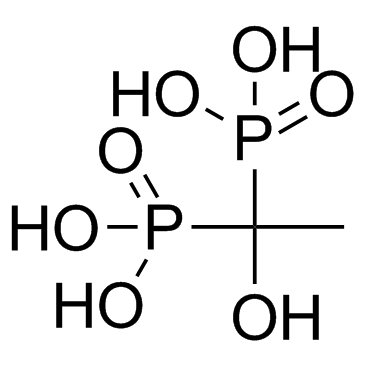Etidronic acid. A review of its pharmacological properties and therapeutic efficacy in resorptive bone disease.
C J Dunn, A Fitton, E M Sorkin
文献索引:Drugs Aging 5(6) , 446-74, (1994)
全文:HTML全文
摘要
Etidronic acid is an orally and intravenously active bisphosphonate, which is believed to inhibit resorption of bone via a number of cellular mechanisms, including alteration of osteoclastic activity. In studies of patients with symptomatic Paget's disease, etidronic acid 5 to 20 mg/kg/day administered orally rapidly decreased the biochemical indices of bone turnover. Mineralisation defects in forming bone may be avoided by the use of an initial dosage of 5 mg/kg/day for up to 6 months; dosages above 10 mg/kg/day should be limited to 3 months' duration, and dosages greater than 20 mg/kg/day should be avoided. Although 3-day intravenous therapy with etidronic acid 7.5 mg/kg/day has shown superior efficacy to rehydration and forced diuresis in the management of hypercalcaemia of malignancy, the efficacy of the drug is lower than that of the newer bisphosphonates, pamidronic acid and clodronic acid. Clinical studies involving postmenopausal women with established osteoporosis have indicated that oral etidronic acid 400 mg/day for 14 days as part of a 90-day cycle, repeated for up to 3 years, increases the bone mineral density (BMD) of the lumbar vertebrae and appears to reduce the incidence of vertebral fracture. Published data suggest that etidronic acid shows similar efficacy to hormone replacement therapy (HRT) in these respects. The above dosage also appears to be effective in preventing corticosteroid-induced osteoporosis when administered as part of an intermittent, cyclical regimen. Etidronic acid in higher dosages (10 to 20 mg/kg/day orally) is effective in reducing the incidence of heterotopic ossification and its ensuing complications in both neurological and post-surgical patients. Etidronic acid is well tolerated by the majority of patients, with gastrointestinal complaints reported most commonly, but tends to delay the normal mineralisation of forming bone when administered continuously at higher dosages for prolonged periods. This is of little consequence where short term treatment is involved, but may be detrimental to those patients receiving longer courses of therapy. This effect may be minimised or avoided by using the lowest effective dosage for as short a time as possible (as in the above recommendations for Paget's disease), or by the use of intermittent cyclical therapy (as in the management of osteoporosis). Etidronic acid therefore retains a role in the management of resorptive bone disease, particularly in the treatment of Paget's disease, the prevention of heterotopic ossification, and as a second-line option in postmenopausal osteoporosis. However, the development of newer bisphosphonates requires that these compounds be continually compared and re-evaluated.
相关化合物
| 结构式 | 名称/CAS号 | 分子式 | 全部文献 |
|---|---|---|---|
 |
羟基乙叉二膦酸(HEDP)
CAS:2809-21-4 |
C2H8O7P2 |
|
Translating clinical findings into knowledge in drug safety ...
2011-12-01 [J. Sci. Ind. Res. 65(10) , 808, (2006)] |
|
Effects of various squalene epoxides on coenzyme Q and chole...
2014-07-01 [Biochim. Biophys. Acta 1841(7) , 977-86, (2014)] |
|
FDA-approved drug labeling for the study of drug-induced liv...
2011-08-01 [Drug Discov. Today 16 , 697-703, (2011)] |
|
In vivo phosphoantigen levels in bisphosphonate-treated huma...
2012-11-15 [Clin. Cancer Res. 18(22) , 6249-59, (2012)] |
|
Biosorption of heavy metal ions onto agricultural residues b...
2012-11-28 [J. Agric. Food Chem. 60(47) , 11664-74, (2012)] |